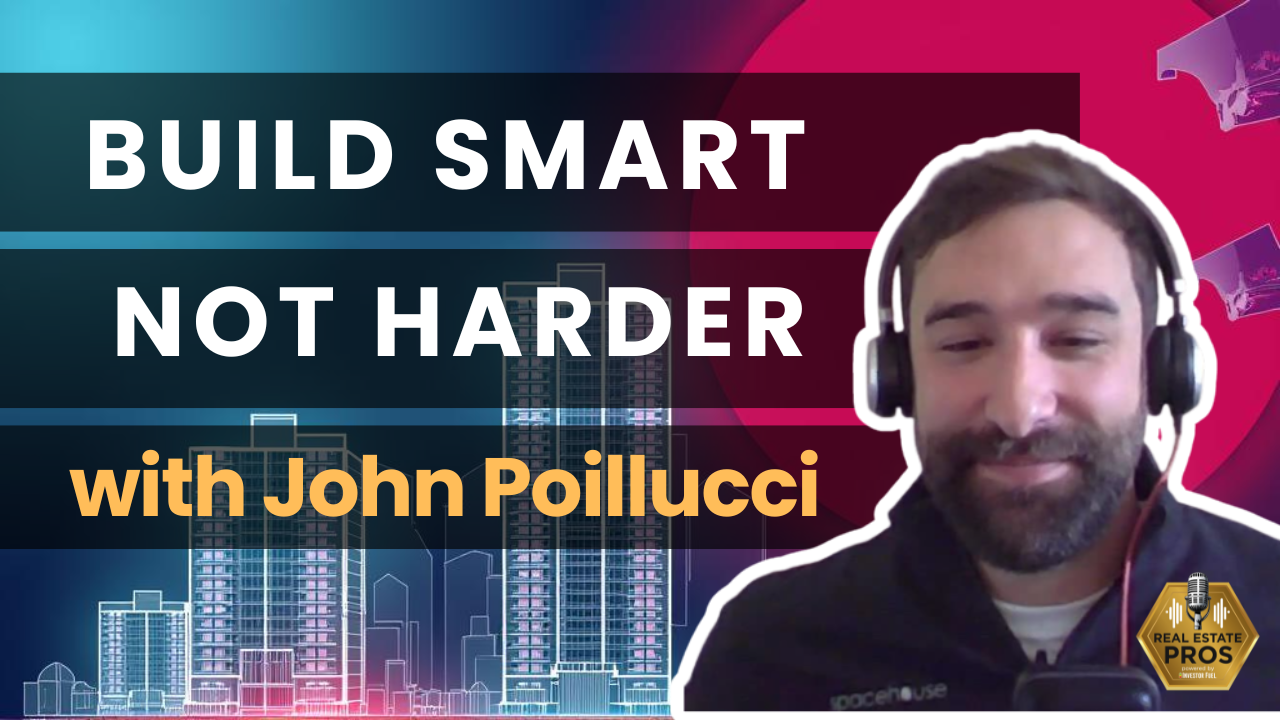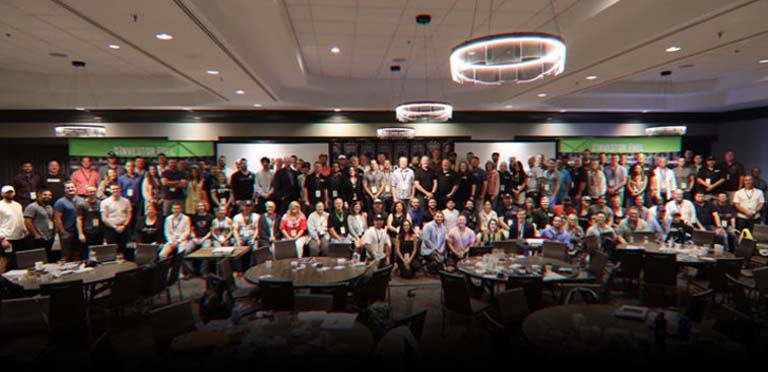
Show Summary
In this episode of the Real Estate Pro Show, host Erika speaks with architect John Poillucci, founder of Spacehouse Studio. They discuss John’s journey in architecture, the importance of collaboration in construction projects, and the evolving landscape of zoning laws that impact housing affordability. John shares insights on navigating risks in construction, innovative approaches to cost reduction, and the significance of building deep relationships in the industry. He emphasizes the need for open communication with clients and highlights his focus on affordable housing as a key goal moving forward.
Resources and Links from this show:
Listen to the Audio Version of this Episode
Investor Fuel Show Transcript:
Erika (00:00.845)
Hey everyone, welcome to the Real Estate Pro Show. I’m your host, Erika. And today I’m so excited to be joined by John Poillucci, an architect who is making serious waves in the construction space and renovation, and he owns Spacehouse Studio. John, it’s awesome to have you here.
John Poillucci (00:19.576)
Great to talk to you, Erika.
Erika (00:21.805)
I think our listeners are really going to love how you’re blending your architectural experience and real estate development and creating some seriously impactful projects.
John Poillucci (00:33.142)
Yeah, yeah, I’m really excited to talk about that today.
You know, my experience in architecture is kind of giving me this unique position where I work with developers and contractors all day and you know, I get to see what a wide variety of different folks are focusing on and and yeah, it’s it’s it’s really fun to you know be part of all these different projects with different priorities and goals But you know, everyone’s trying to get across that finish line to you Get their project finished sold move on to the next thing that type of work. So Love to share, know my experiences with that
Erika (01:07.693)
Yeah, so tell us about how you got started.
John Poillucci (01:10.742)
Yeah, sure thing. So I got started after I’d say I
It was about, gosh, year 10, 11, 12, something like that in the field. you know, I got into architecture always with the end goal of wanting to start my own firm. But to get to that point, you had to wear a few hats ahead of time. And before, you know, I felt comfortable really delivering excellent services to my clients. so yeah, I worked in residential architecture up in New England area, and that’s where I was born and raised. And, you know, my, journey has led me
me around the country a little bit where I worked in different types of…
types of architecture. So that includes multifamily construction, single family, duplexes, triplexes, any kind of middle housing type you could think of. And then for a short while, I was also working in healthcare architecture. And yeah, it’s led me that route. And I was really excited to work with some great, great teams, great clients. And now I’ve started Space House Architecture about three years ago, and always with the focus on residential architecture and delivering
great designs with deep trusting relationships. And I work a lot with contractors and developers. Those are my number one client type. I find this really great because they’re in the industry and I like to provide their offices with some horsepower in delivering those projects.
Erika (02:38.733)
Which markets are you operating in?
John Poillucci (02:41.472)
Yeah, so through my moves and all that, I work in both the Pacific Northwest as well as the Northeast. So that could span from, I’d say as north as Maine and as south as Pennsylvania and New Jersey. So those areas.
Erika (02:57.443)
So for anyone who’s looking to expand their line of work, what kind of advice would you give them, working in different regions and just juggling everything?
John Poillucci (03:08.268)
Yeah, so if you’re trying to expand your line of work, would say do it in, I’d say, a slow and measured way because jumping from, let’s say you’re doing a first flip or something like that, and then it’s quite a jump to go into something that’s a multifamily project because there’s a lot more considerations with codes and everything. Of course, I’m always going to advocate for working with architects, but
you’re making those jumps there’s little things to take along the way but
So I think doing it in a way that, you know, maintains the, an excellent delivery of the project. And like maybe that could be yourself as the client. Maybe you are building a project to rent and, but you want to make sure that you checked all the boxes. You can get to that finish line successfully. And, and then it might be a different client. It might be, you know, you’re building it to sell, you’re building to sell a specific client. You know, how do you, you know, set their expectations and make sure you deliver that well. But at the same time,
It’s growth is uncomfortable and requires some risk. So, you know, I see people that make these big jumps and they get out just fine. But I just say, you know, if you are growing in a more substantial way to really lean on your network and just meet people and talk about their experiences, know, construction, every building is unique, but it is no need to reinvent the wheel. I’d say there’s known ways to get to your finish line and just leaning on the people around.
you.
Erika (04:45.261)
love that. You were talking about taking risks. think every developer or investor that has their eyes on a property that they want to transform, what’s key to balancing having a creative vision and also looking at the practicality with a project?
John Poillucci (05:04.046)
Yeah. So that’s that’s a really good question. And, um, you know, it’s, it’s always fun to be in that mindset when you’re first looking at a site and there’s just like infinite possibilities, right. Um, before you start digging into the zoning code and the environmental constraints and whatever it might be. um, it’s, I think, um, there, is little risk if you can, um, have successful due diligence ahead of time. And then, um, so that just means really digging into, um, you know, what are the skeletons that are possible?
could come out of the closet with any project. then there’s upfront cost with that too sometimes. So I think coming up with systems that, you know,
to look at specific things for sites. you know, it’s okay, like, let’s say it’s a new site or an existing building or whatever it might be. It’s, you know, you can have your list of looking through the building code, zoning code, and talk with the fire marshal, talk with the building department, just going through those processes. And depending on, you know, how robust the project might be, there, it’s really worthwhile to, you know, sometimes lean on those professionals if you really
making a large investment in, let’s say, it’s a greenfield site, for example. I see a lot of developers and contractors just start building. But there’s risk in any kind of construction. So some of the things you can do to get out of the way is get your geotechnical reports done, and then actually understand, OK, you have this beautiful lot, but what’s actually going on under the hood? And do you want excavation to start and not know what you’re actually digging into yet? Things like that. And you’re surveying.
if it’s like a really constrained lot with property lines and everything. If you don’t have a survey in place or something like that, then you don’t really know what your canvas is that you’re painting on yet. might be possibly winging some property line adjustments or something like that. At the same time, if you have a survey in hand, you can maximize your investment. so there’s some of these upfront costs that there are risks
John Poillucci (07:15.596)
and they kind of track from the overall cost of a project, but at the same time, you can get immense value out of it and maybe you’ll deliver the project sooner and maybe you reduce holding costs or maybe you just be able to sleep better at night, honestly. yeah, I think it’s just really digging into the prospective project as much as possible ahead of time is just gonna really pay dividends in the end.
Erika (07:42.467)
Fifth great advice, John, given your expertise, what’s one trend in construction or renovation that you think real estate investors should be paying attention to right now, especially if there’s an opportunity to maximize property value?
John Poillucci (07:58.285)
Yeah. So, the number one thing I’m thinking about right now is, zoning laws. So across the country, we’re seeing, different, so I’ll back up a little bit, but, I’d say in the world of residential construction, you know, we’re really feeling a squeeze with, you know,
property values are rising, people can’t afford homes, things like that. And lawmakers are beginning to, well, had been noticing this and they’re really starting to make some changes on this. instead of where like you might have a single family lot and all you can build on that is a single family home, which is great. And like we need homes like that, but we also would benefit a lot from different types of homes. So if we look at something like a duplex, right, is, you know, that’s two homes, but they share a roof and a foundation.
So that cost gets diversified between those two units. Same goes for four-plexes, multifamily.
You know, just having diverse housing types like that really puts more products out in the market that people can afford or it adheres to a different demand as opposed to only one type of home being a single family home. you know, across the country, we’re seeing laws come up at the state level, city level that allow more types of construction where only one home would have been allowed before. And this concludes things like accessory dwelling units. So actually just yesterday,
I learned that in New Hampshire you can have a single-family home, but in the backyard or attached to it You can build another smaller home. That’s an accessory dwelling unit. They call it so what’s important about that is Where you you had a lot and you have all the costs associated with and you can build one home and sell it for that known price Now you can build two homes so it essentially like cuts in half the land cost and the infrastructure cost and That’s a that’s a big deal as far as you
John Poillucci (09:53.308)
making a project pencil. And it’s going to be different clients, different markets and everything. But what we’re seeing is we’re able to divvy up that land cost quite a bit. also these are lots that are already improved. Let’s say it already has a home on it and you can build another one right next to it and make it a duplex. don’t have to pay all the… Being an improved law, you don’t have to pay for sewer hookups, water hookups, electric hookups. Or if you do,
It’s already existing and you don’t have to worry about if you have to tie into it in a certain way. So yeah, what we’re seeing is I think a really profound change in the value of land with these new laws in place. And there’s going to be some regulatory hurdles, I think, as you know. It’s a new zoning code. And then if we like…
propose a building and that might be the first that building department has ever worked with that type of building. Maybe it’s a duplex in a single family lot or an ADU. And so they have to really scrutinize that project and see how do we get this thing approved and can we approve it. And that’s what I love to work with people on is figuring out how to navigate that process in an effective way that really gets their end product finished.
Erika (11:11.885)
That’s really cool and it sounds like even though there’s challenges, there’s a lot of opportunity at the same time.
John Poillucci (11:17.9)
Yeah, for sure. Yeah, it’s and I’m excited that so with my background, I worked a lot in the Pacific Northwest and states like Washington, Oregon, California. They’ve had these laws in place for years now. And what’s exciting is
Those communities are starting to see a positive trend in housing affordability. So they’ve been able to add in some housing types like ADUs and townhomes and things like that, where it used to be only single family homes. And now they’re seeing the average housing costs go down actually. And that’s really impactful and people can afford homes more easily in those areas. At the same time, the law might be in place and it takes time.
for it to get the client that wants to have that done, or if it get the land that you want to build this on, and then after that, get the construction started and get the home completed and sold. So we’re gonna see a lag from when these laws are put in place until it has an impact on housing costs and those types of trends, but they’re really powerful tools to change how we value land and how we value a project.
Erika (12:32.961)
I love that. really, we don’t have a lot of people on the show that talk about how to get housing costs going down, but also that you get a return on your investment. That’s just really awesome.
John Poillucci (12:45.718)
Yeah, yeah. And there’s definitely more to, you know, that’s one lever we have to pull with housing costs is, you know, the cost of the land and the zoning laws. But then you can look inward too, is how do we look at the buildings themselves and how do we work with best practices to get that housing cost down? So, you know, there could be small things like, you know, I have like a catalog of plans that, you know,
They’re just like home designs that are complete that you know I can I can essentially deploy them a few times and then people are able to access that at a lower cost than say a custom home because I’m able to diversify my time but there’s there’s small changes in these these plans like They’re they’re round numbers for the dimensions of the floor plate So it’s like okay It’s a 20 by 40 foot building and then the framers don’t have to think as hard about you know how they make their cuts and like maybe they’re rectangular in shape as opposed to having a
a lot of articulation and this might bring the cost down by a half a percent or something like that. But when you add all these features together, you can have a significant impact on construction costs and really drive down your cost per square foot for new construction. even still in, I’d say in renovation type projects, there’s more things you can do to really focus on labor savings and how do you get to your end product in the same way.
It looks the same, but how do you get there in a quicker way, but also that it’s a quality construction and you’re able to get more in your investment.
Erika (14:23.277)
Yeah, yeah. Talking about cost there. Maybe this is cost related, maybe it’s not. Every pro in this industry has a moment where things got real. Maybe a project hit a major snag or clients demands pushed you to think outside of the box. John, can you share one of those moments in your career and how did you navigate it?
John Poillucci (14:46.613)
yeah, you know this is, I had a recent experience with a…
municipality that so a big project type I have right now is a multi-generational living. So that means, you know, it’s like a family that combines their resources and either builds a home together or expands a home. that a project I had recently was, you know, it mom and dad. They lived in a nice like duplex and then they had kids and those kids live in the house and they decided to live at the kids house, but they wanted to build an addition onto
existing home and in that case they it was pretty simple project. It was about a 700 square foot addition and they want a bedroom and a small living area and essentially like a wet bar that they still wanted to share meals with their family and everything and you know experience life together but have like some privacy and separation and that wet bar actually was like such a big thing with the zoning approval because
Because in this specific municipality, you can have accessory dwelling units, meaning like a smaller version of a home that’s on the same lot. And then what defines an accessory dwelling unit is it has the whole eternity of a home. has a bedroom, a bathroom, and it also has a kitchen. And then the kitchen is what got open to interpretation is, by that definition, is like a cooking facility. So in this case, it was a sink. And then you can technically prepare food.
on the countertop next to it. So we had to either
John Poillucci (16:26.478)
for this project to move forward in the version they wanted, which is like contiguous area. So like their new unit has a doorway into the existing home. They had to either get rid of that small little wet bar, or they had to completely separate with a one hour rated wall between the new addition and the existing home. So we really just like dove into, you know, what’s the value of one situation versus the other. And they ended up opting for,
to keep that wet bar area, the small…
It’s called a kitchen area and we’re going to separate the two units. And then what happened is, um, you know, they were able to walk out one door and walk into the other and still experience life together. But if they want to turn around and move out of that place and rent out that second unit, they could, it’s legally like a, it’s almost like a duplex. It’s, um, it’s like one smaller unit and existing home and they’re attached together. And, um, yeah, it was, uh, it was an experience as far as permanent goes and everything. But, um, and like that, that’s a real challenge.
is like, want to move forward and you have families moving in together and they have timelines and there’s a lot of emotion and life changes to hide to that. it’s making these big decisions and navigating that lifestyle change at the same time. That’s a lot. That’s really challenging stuff. But at the same time, we were able to…
you know, make a better ROI for their project because they can turn around and have two homes where they had one before in this previous version. So in the end, it kind of made out better for them, but it was just, it was definitely challenging for sure.
Erika (18:08.045)
What was the biggest takeaway that you had from that experience?
John Poillucci (18:11.854)
I think the biggest takeaway was
I think just continuing open collaboration with clients. So that’s something I’ve really loved to do with contractors and developers I work with is just like talk through the project as much as possible. It’s not like a top down approach. Like people think, you know, I’m the architect. I’m to have all the answers or something like that. And like, I have my experiences, but then contractors have their experience. Developers have their experiences. Clients have their own experiences. And how do we bring all of our knowledge together to make the most successful
project possible. So in that case it was, you know, I had my understanding of the zoning codes and building codes and they had their, the client had their goals and their understanding of, you know, the finances behind it I’d say. And, you know, how do we merge these two together to make the most effective solution. So I think it’s just open continued communication is the biggest takeaway from that.
Erika (19:12.543)
Excellent, excellent. That is a great takeaway. John, you mentioned how managing both of those markets, that making those connections and networking made all the difference. Can you share more about that? What specifically was the biggest game changer for you for growing your network as an architect and working with investors?
John Poillucci (19:37.302)
Yeah, I think, in this day and age, it’s there’s so much focus on, web marketing and, you know, networking online, that type of thing. but then I kind of look to, my support crew, would be just like mentors, other people in the industry and just see how they work and people that have been doing this for a long time. And, time and time again, the biggest impact, like the most impactful way, to put yourself out there in the network is, just meeting people, just talking. And, I really.
value the power of in-person interaction and just making deep relationships. I’m very much like go for the narrow and deep relationships. Find who complements your strengths best. How do you…
Position yourself in a way that you’re working with people that see the same goals as you and like maybe in different ways and they might be different personalities or whatever it might be but like from a business perspective, who are the people that are gonna really drive you forward and how and are these people you’re gonna drive forward as well? So it’s like it’s two-way street, yeah, it’s you really focus you know, I wouldn’t say like
go for that wide approach. And it’s good to have like an online presence and everything. That’s always fun. making deep trusting relationships is really going to pay off when you’re having these long projects. it’s, you know, I think about like contractors that are in the field every day and they’re at a project for like sometimes years and years. And you want to make sure that those relationships are really solid before you get started with something like that. Because
projects get tough, they get tough almost every single time. And there’s just going to be ups and downs and to be experiencing that with people that you really trust and you feel comfortable with, that’s going to just be beneficial for the project, for yourself, for everyone around you too.
Erika (21:38.977)
I couldn’t agree more. John, what is next on the horizon? What goals are you looking to achieve?
John Poillucci (21:44.334)
Mm.
John Poillucci (21:48.108)
Yeah, so next on the horizon for me is…
You know, I’ve got these great relationships in and now I’m really focused on, I’d say affordable housing, naturally occurring affordable housing is my big product that I like to put out there. So I really enjoy collaborating with contractors and developers in making a product that like, you know, works with their brand. But we’re able to make beautiful homes that are put out in the market in a way that’s
know, suitable for construction, make things easier. I think a lot about like prefabrication and just clever design that, you know, sets up things like, you know, I’m really thinking about like, okay, how do I set the plumber up for success here? How do I make their life as easy as possible? And then I think about, you know, it’s not necessarily like a labor savings, because it’s like, it’s going to be hopefully for the same labor, we can build two homes as opposed to one.
Like that kind of idea is like, I’m not trying to push like one trade out or anything like that. It’s like, how do we get these trades to have a wider throw and create more housing? And that’s, know, the designs I try to put out there. That’s what the focus is, is, you know, how do we.
make this so it can be recreated easily. some of my clients are, I’ve had clients that are just homeowners that they’re building their first ADU or first renovation or something like that. And I’m able to make that leap with them because we’re really focused on simplified building techniques and how do we get to their goal in a way that’s, like if I had a drywall or come out of a project and they’re like, that was the easiest house to drywall I’ve ever done.
John Poillucci (23:33.2)
I’m like, I’ve done my job well. Because if someone, a tradesman, looks at a project and is like, this looks like a headache, when the goal is to make any kind of homes that people can afford, then that’s not successful to me.
Erika (23:50.051)
John, I love how you’ve been able to blend creativity and practicality so well. If someone on listening today wants to get in touch with you, collaborate, what’s the best way for them to connect?
John Poillucci (24:05.774)
Yeah. So everyone communicates in different ways and I like to, um, you know, let people get in touch with me the best way possible. So if you like a phone call, I have a website, spacehouse studio.com. I have my email on there. have a social media. Um, I’m on LinkedIn, Instagram, Tik TOK, Facebook, you name it. And, um, you know, I’m happy to interact with people in just about any way. And, um, you know, feel free to give me a ring. If you’re thinking about a project or, um, you know, just like, I want to bounce your ideas off of somebody. I’m always happy to have a quick conversation.
and just hear what you’re saying, where the fears might be in a project or that growth. I’ve worked with people of all different scales of projects. you can achieve these goals, these bits of growth. People have done it before, and they’ve done it successfully. So I’m lucky to be in a position where I of bear witness to that. So yeah, feel free to get in touch with me any way you’d like.
Erika (25:06.649)
Thanks so much for sharing your insights and journey. I’m sure there’s people out there taking notes and if they didn’t, wow, they need to go listen again and take more notes. Thank you.
John Poillucci (25:16.245)
Yeah
Thank you, Erika. It’s been a real pleasure talking through this and I’m really excited about what a resource this podcast is to folks in real estate and seeing real estate become more accessible to people, seeing just private homeowners or just people that want to make a difference in their neighborhood all the way up to folks that want to make big developments and such. So I’m really excited to see this podcast continue to make such a good influence.
Erika (25:47.481)
For everyone tuning in, if you found this episode valuable, make sure you’re subscribed. We got more conversations like this with pros like John who are shaping the real estate world. We’ll see you on the next episode.









